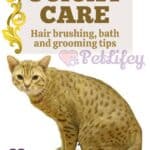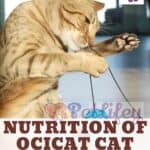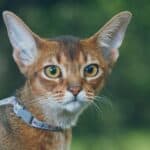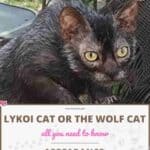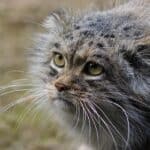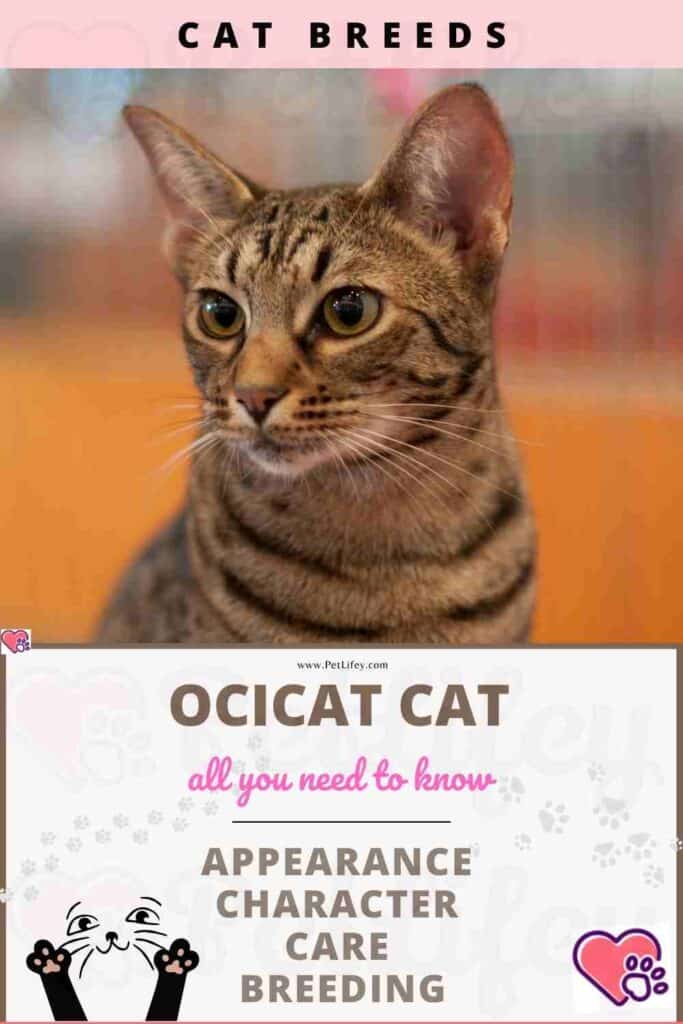
Selected in America, the Ocicat cat derives from crosses between Europeans , Abyssinians and Siamese; it is precisely from these latter that it inherited its very sensitive and exclusive character.
Physically much larger than its ancestors, it has the charm and beauty of wild felines that it also recalls by name, Ocicat being the contraction of ocelot and cat (“cat” in English). The ocelot, let us remember, is a wild feline with a splendid spotted coat, of medium size, which lives in Central and South America.
The Ocicat, although being very attached to its master, is an independent cat and always on the move, that one cannot force to live in a restricted environment because it needs to have at its disposal rather large spaces. The ideal for them is a house with a large garden.
The origins of the Ocicat Cat
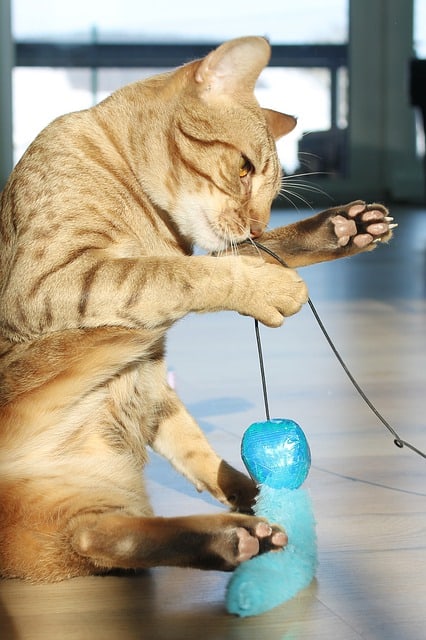
The ancestor of all Ocicates was born by chance in a litter of two Siamese. The father was a chocolate point – her dress had chocolate-colored tips – while the mother was a very rare Abyssinian point – her tips were the warm color that distinguishes the Abyssinian dress.
The kitten in question had a coat with phantom markings spotted, that is to say spotted, really unpredictable in a Siamese, which was considered very interesting, to the point of deciding to create a new breed that exhibits this characteristic. To obtain it, he and its descendants were crossed with Europeans and Abyssinians; this not only served to fix the characters of the dress, but also influenced the physical structure, which gradually passed from characteristics peculiar to the Siamese to the present, with a medium tall, strong, elongated, low and solid morphology.
Appearance of the Ocicat Cat
It is tall, has strong and robust bones and muscles, and a distinctly athletic appearance in general.
The head, proportionate to the body, has the shape of a rounded triangle, the profile is long and emphasizes a gentle rise from the muzzle to the eyebrows; the muzzle on the other hand is more or less square and well drawn.
The ears are moderately large and set at the angles of the head; we appreciate very much that they are provided with tufts on the points, like those of the lynx.
The eyes are large, set wide and almond shaped, slightly sloping towards the ears; all colors are allowed, but do not necessarily have to match those of the dress, except blue.
The body is semi-elongated, that is to say between the elongated and the short, with a rather deep chest and prominent ribs; the body can be horizontal or even slightly higher on the posterior quarters; the sides are straight.
The legs are moderately long and proportionate to the body, they have a strong bone structure and are very muscular. The feet, proportioned to the legs, are oval and compact.
The tail, quite long and rather thin, is thicker at the base to thin out slightly towards the tip, which is always dark.
The thick, abundant and adherent coat, with a fine texture, is long enough to have several bands of color (ticking). On the areas of the dress where these bands overlap, a tabby pattern is formed with spots, or spot, the shape of which is reminiscent of a thumbprint.
The spots are dark on a light base, or more precisely, inside the spots of the tabby pattern, the hairs have darker colored tips while those of the base color have them lighter.
Coat color of the Ocicat Cat
All color tones should be bright and crisp. Around the eyes, on the chin and on the lower side of the jaw, the color is lighter, the darker being on the tip of the tail.
The characteristic ticking spots should be well demarcated and visible in all directions. The colors are brown for the background and black for the spots.
More rarely, the background can be silver, but other colors are also allowed, with the exception of red.
The character of the Ocicat Cat
The Ocicat cat, on the other hand, has retained most of the character of the Siamese, who is “nervous”, lively and impetuous; like its ancestor, it too is sociable and ready to give a lot of affection to its master, but only to them.
He is an intelligent and very curious cat, snooping around and always looking for new adventures.
Hug:
The Ocicat is very affectionate in general and will be an integral part of your life, despite the fact that you will never quite earn their trust.
Player:
Its build makes them an agile athlete who can easily jump, leap and run. Better to give it large, stable cat trees and heights to allow it to occupy itself elsewhere than on your curtains or kitchen worktop.
Calm:
This cat will be quite gentle and calm, once its long daily explorations are completed.
Intelligent:
It is not only its elegance that we can admire but also its curiosity that makes them a very smart cat, able to quickly learn what is asked of them.
Fearful / suspicious of strangers:
Rather interested in what is going on around them, the Oci will quickly notice something new. By offering them a hiding place or a height so that it can observe first, there is a good chance that he will choose the right time for them to get to know them.
Independent:
The Here can spend their time with or without you, depending on their mood.
Behavior of the Ocicat Cat
Talkative:
Are there not Siamese or Abyssinian ancestors in this cat to explain that it can chat a little with you? Yes, although some people may enjoy chatting more than others. But their voice is definitely not as loud as that of the Siamese.
Greedy / gluttonous:
Given the energy that it can spend moving around with ease, it goes without saying that it must regularly recharge its batteries with a good small meal. So that it eats more slowly if it is greedy, it is better to offer them its meals in an interactive bowl.
Need for exercise:
This athletic feline with amazing prowess needs to play and exercise every day. A feather duster or a fishing rod-type toy allows them to show you what it is capable of.
Runaway:
The leaps that the Ocicat is able to make allow it to easily climb a wall or a fence. Consider securing its environment if you want to keep it with you.
Compatibility of the Ocicat Cat with other animals
The Ocicat and the Dogs:
By introducing them the right way and providing heights and hiding places for your cat, you give your two companions a better chance of learning to cohabitate.
The Ocicat and the Other Cats:
This feline does not need the presence of a congener to overcome the loneliness in your absence.
On the other hand, if you really want to have other cats, the Ocicat is quite capable of adapting, provided that their introduction is made according to the rules of the art.
The Ocicat and the Children:
It looks like a little beast and you fear for your children? Rest assured, this cat can be a good companion for the whole family. It is enough that the children know how to respect the cat and that the relations are courteous.
The Ocicat and the Elderly:
As it gets older and more experienced, this cat can be of a more calm and poised nature to make a cat of good company. But when it is young it is mischievous, requires a mission of surveillance and play that a relatively calm person may not have the opportunity to accomplish.
Price of the Ocicat Cat
On average, the purchase price of an Ocicat kitten in breeding is between 850 USD and 1700 USD . The price varies according to the lineage of the kitten, the breeding, the age at the time of its acquisition or even the sex. For the monthly budget, it will take an average of 50 USD per month to meet the needs for the purchase of quality bedding and food.
Maintenance of the Ocicat Cat
Grooming:
Regular brushing will suffice for its easy reputation maintenance.
Hair loss:
During the moulting period, it should be brushed every week.
Food of the Ocicat Cat
It is quite active, which requires good quality food to help keep them healthy.
Health of the Ocicat Cat
Life
expectancy : Its life expectancy is between 12 and 15 years .
Resistant / robust:
Its short hairs give it a rather average resistance to the cold while its tolerance to heat is better.
Tendency to
gain weight : If they cannot find something to occupy or there are not regularly new toys in their toys on a daily basis, the Ocicat may be bored and find it interesting to nibble. It should be checked regularly that it is not gaining weight, which could cause health problems.
Frequent diseases:
The Ocicat can one day develop the same pathologies as any other cat such as oral pathologies. Some diseases are specific to its breed:
- Progressive retinal atrophy is a disease that can lead to blindness in this breed. A screening test exists
- Hypertrophic cardiomyopathy results in thickening of the heart muscle. By decompensating, this pathology causes heart failure which can result in arrhythmias, or even edema of the lung. Screening is carried out by an echocardiography examination, to be repeated in general on an annual basis. Treatment can be given to improve comfort.
Reproduction:
The number of kittens per litters is average, ie around four.
As marriages with the Abyssinians have been prohibited for at least ten years, only marriage with another Ocicat is authorized.
Good to know
This breed does not allow the presence of medallions or even speckles of white color.

